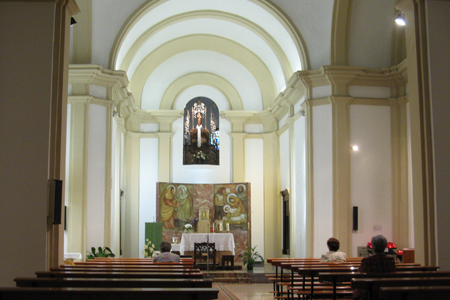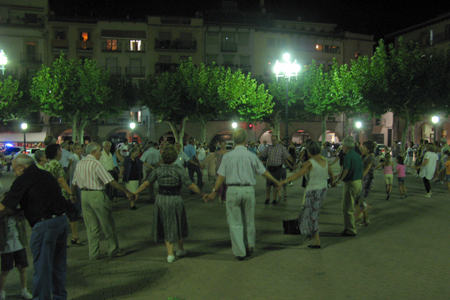| |
 |
 |
 |
| Comment on this report, or find other reports. |
 |
| Our Mystery Worshippers are volunteers who warm church pews for us around the world. If you'd like to become a Mystery Worshipper, start here. |
 |
| Find out how to reproduce this report in your church magazine or website. |
|
|
| 1883: Mare
de Déu del Miracle, Balaguer, Catalonia, Spain |
 |
 |
 |
Mystery Worshipper:
Augustine the Aleut.
The church:
Mare de Déu del Miracle (Mother of God of the Miracle), Balaguer,
Catalonia, Spain.
Denomination:
Roman Catholic, Diocese
of Urgell (the bishop is also co-prince of Andorra, along
with the President of France).
The building:
Dating largely from the 12th century, it appears to have been
rebuilt most recently in the 18th century. Any baroque retablo
was recently removed and replaced by a modern altarpiece.
The church:
It is a former synagogue. It's not clear when it was converted
to its current use. There was terrible repression of the Jews
in the kingdom of Aragon in the 1390s and, after the Council
of Tortosa in 1413, many Jews agreed to baptism, surrendering
their synagogues to be made into churches. The synagogue in
Saragossa became the Church of the Miracle and we might guess
that this dedication was emulated here in Balaguer. In any
case, the remaining Jews of Catalonia were given the options
of baptism or removal by the 1491 decree of Isabel the Catholic
(whose cause for canonization is currently in the doldrums).
The church appears to be used for concerts and lectures as
well as for religious services.
The neighbourhood:
This is a thinly populated part of Catalonia, with substantial
Castilian and Aragonese-speaking minorities. Balaguer was
conquered from the Moors by Ermengol VI, Count of Urgell,
in 1106; he made it his new capital, and it remained so for
subsequent counts of Urgell. The town was Franco's entry point
into Catalonia during the civil war, and there are still a
few bullet holes around. This church is in the old town, more
precisely in the old Juderia (Jewish quarter) toward the southwest.
The district is poor and there is little luxury evident: it
is down the street from the local museum, and about 200m from
the Plaša Mercanal.
The cast:
No idea. Looking at the Balaguer
parish list (several churches seem to be organized in a team
ministry), it might well be Juan Pablo Esteban Osma, given
his relatively youthful age.
The date & time:
Thursday, 11 September 2009, 8.00pm.
What was the name of
the service?
Evening Mass.
How full was the building?
There were about 10 in a nave which could hold 100. Almost
all of them were older women from this working-class area.
Did anyone welcome you
personally?
I was certainly noticed as I came in, as I was the only male
there, and likely the first new face they had seen at a weekday
mass.
Was your pew comfortable?
The bench was a bit narrow, but it was nothing I couldn't
handle. The angle of the seat was not helpful, but as I did
not expect to be there for more than half an hour, I determined
to deal with it with a combination of fidgeting and sacrificial
meditation.
How would you describe
the pre-service atmosphere?
This was a very quiet church, and parishioners were not making
a lot of noise.
What were the exact
opening words of the service?
"En el nom del Pare, del Fill i de l'Esperit Sant."
What books did the congregation
use during the service?
No service books, as is the Spanish practice.
What musical instruments
were played?
None.

Did anything distract
you?
Nothing in particular, but I was conscious that this was a
former synagogue, and its worshippers had been ethnically
cleansed out of their home a half-millennium ago.
Was the worship stiff-upper-lip,
happy clappy, or what?
The youngish priest took us through the novus ordo mass at
a comfortable clip.
Exactly how long was
the sermon?
5 minutes.
On a scale of 1-10,
how good was the preacher?
7 – I mark for voice modulation and eye contact, as my
Catalan is not good.
In a nutshell, what
was the sermon about?
I couldn't understand a word. He was using an appalling sound
system.
Which part of the service
was like being in heaven?
The close attention of the parishioners to the service.
And which part was like
being in... er... the other place?
I could not ignore that I was in a building that had been
stolen. Even after six centuries, there was still an odd feeling
about the place.
What happened when you
hung around after the service looking lost?
Not too much. Everyone scattered out of the church, and I
barely had a chance to snap a photograph or two.
How would you describe
the after-service coffee?
None available here, so I wandered out into the main plaza
and took a seat at a restaurant table. Halfway through my
grilled rabbit, a brass band set up on some benches, and about
60-80 people spontaneously entered the square from all directions
and began to perform the traditional Catalan dance, the sardana.
How would you feel about
making this church your regular (where 10 = ecstatic, 0 =
terminal)?
2 – While the congregation would likely get to be warmer
as they saw the stranger resurface a few times, I was really
quite spooked by the knowledge that it was a stolen temple.
Did the service make
you feel glad to be a Christian?
Not particularly, given the circumstances. Still, the renovation
job was not that bad; the workers had taken care.
What one thing will
you remember about all this in seven days' time?
Perhaps I was a bit prurient, attending a service there while
knowing the church's provenance, and wondering how the experience
might feel. Now I know.
More Camino reports |
|
|
 |
 |
 |
| We rely on voluntary donations to stay online. If you're a regular visitor to Ship of Fools, please consider supporting us. |
 |
 |
 |
| The Mystery Pilgrim |
 |
| One of our most seasoned reporters makes the Camino pilgrimage to Santiago de Compostela in Spain. Read here. |
 |
 |
 |
| London churches |
 |
| Read reports from 70 London churches, visited by a small army of Mystery Worshippers on one single Sunday. Read here. |
| |
|
|
|
|


